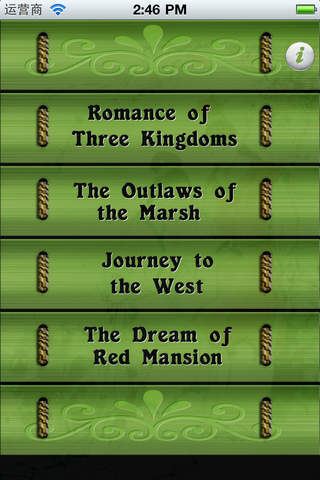Traditional Chinese 四大名著 Hanyu Pinyin Tâi-lô sù-tāi bîng-tsok | Simplified Chinese 四大名著 Yale Romanization sei-daaih mèhng-jeuk Number of books 4 | |
 | ||
Literal meaning "Four Great Famous Works" | ||
The Four Great Classical Novels of Chinese literature are the four novels commonly regarded by Chinese literary criticism to be the greatest and most influential of pre-modern Chinese fiction. Dating from the Ming and Qing dynasties, they are well-known to most Chinese either directly or through their many adaptations to opera and various popular culture media.
Contents
They are among the world's longest and oldest novels and are considered to be the pinnacle of China's achievement in classical novels, influencing the creation of many stories, plays, movies, games, and other forms of entertainment throughout countries in East Asia, including Japan, Korea, and Vietnam.
Works
In chronological order, they are:
Background
Chinese fiction, rooted in narrative classics such as Shishuo Xinyu, Sou Shen Ji, Wenyuan Yinghua, Da Tang Xiyu Ji, Youyang Zazu, Taiping Guangji, and official histories, developed into the novel as early as the Song Dynasty. The novel as an extended prose narrative which realistically creates a believable world of its own evolved in China and in Europe from the 14th to 18th centuries, though a little earlier in China. Chinese audiences were more interested in history and were more historically minded. They appreciated relative optimism, moral humanism, and relative emphasis on collective behavior and the welfare of the society.
The rise of a money economy and urbanization beginning in the Song era led to a professionalization of entertainment which was further encouraged by the spread of printing, the rise of literacy, and education. In both China and Western Europe, the novel gradually became more autobiographical and serious in exploration of social, moral, and philosophical problems. Chinese fiction of the late Ming dynasty and early Qing dynasty was varied, self-conscious, and experimental. In China, however, there was no counterpart to the 19th-century European explosion of novels. The novels of the Ming and early Qing dynasties represented a pinnacle of classical Chinese fiction.
The scholar and literary critic Andrew H. Plaks argues that Romance of the Three Kingdoms, Water Margin, Journey to the West, and The Golden Lotus collectively constituted a technical breakthrough reflecting new cultural values and intellectual concerns. Their educated editors, authors, and commentators used the narrative conventions developed from earlier story-tellers, such as the episodic structure, interspersed songs and folk sayings, or speaking directly to the reader, but they fashioned self-consciously ironic narratives whose seeming familiarity camouflaged a Neo-Confucian moral critique of late Ming decadence. Plaks explores the textual history of the novels (all published after their author's deaths, usually anonymously) and how the ironic and satiric devices of these novels paved the way for the great novels of the 18th century.
Plaks further shows these Ming novels share formal characteristics. They are almost all over 100 chapters in length; divided into ten chapter narrative blocks which are broken into two to three chapter episodes; arranged into first and second halves which are symmetrical; and arrange their events in patterns which follow seasons and geography. They manipulated the conventions of popular story telling in an ironic way in order to go against the surface meanings of the story. Three Kingdoms, he argues, presents a contrast between the ideal, that is, dynastic order, and the reality of political collapse and near anarchy; Water Margin likewise presents heroic stories from the popular tradition in a way that exposes the heroism as brutal and selfish; Journey to the West is an outwardly serious spiritual quest undercut by comic and sometimes bawdy tone. Jin Ping Mei is the clearest and most sophisticated example; the action is sometimes grossly sexual, but in the end emphasizes conventional morality.
Influences
The four novels were highly influential in the development of vernacular works in Chinese literary history. Traditionally, fiction and drama were not held in "high regard" in the Chinese or East Asian literary hierarchy, and they were generally not seen as true "literature" by scholars. Writers in these forms would not have the same level of prestige as poets or scholars of Chinese classics would have had.
All four of the novels were written in a style that is a mixture of Classical and vernacular Chinese, with some that are more completely vernacular than the others. For instance, Romance of the Three Kingdoms is known for its mix of classical prose with folklore and popular narratives, while the Dream of the Red Chamber is known for the use of poetry within its mostly vernacular style. These four novels are thought to have popularized, and more importantly "legitimatized" the role of vernacular literature among the literary circles of China.
Other great classic novels
The term "classic novels," writes Andrew H. Plaks, is a “neologism of twentieth century scholarship" which seems to have come into common use under the influence of C. T. Hsia’s Classic Chinese Novel. Paul Ropp, following Hsia's selection, notes that “an almost universal consensus affirms six works as truly great,” including, in addition to those above The Plum in the Golden Vase by Lanling Xiaoxiaosheng and The Scholars by Wu Jingzi.
Because of its explicit descriptions of sex, The Plum in the Golden Vase has been banned for most of its existence. Despite this, many if not most scholars and writers, including Lu Xun, place it among the top Chinese novels.
